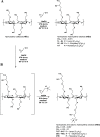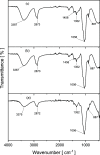Evaluating the Role of Hydrophobic and Cationic Appendages on the Laundry Performance of Modified Hydroxyethyl Celluloses
- PMID: 36193443
- PMCID: PMC9523713
- DOI: 10.1021/acs.iecr.2c01698
Evaluating the Role of Hydrophobic and Cationic Appendages on the Laundry Performance of Modified Hydroxyethyl Celluloses
Abstract
Soil-release polymers (SRPs) are essential additives of laundry detergents whose function is to enable soil release from fabric and to prevent soil redeposition during the washing cycle. The currently used SRPs are petrochemical-based; however, SRPs based on biorenewable polymers would be preferred from an environmental and regulatory perspective. To explore this possibility, we have synthesized SRPs based on hydroxyethyl cellulose (amphiphilic HEC) appended with controlled compositions of hydrophobic and cationic appendages and assessed their cleaning abilities. The results demonstrate that the introduction of hydrophobic lauryl appendages onto the HEC backbone is essential to deliver anti-redeposition and soil-release performance. Conversely, further introduction of cationic groups onto hydrophobic modified HECs had no clear impact on soil-release performance but caused significant disadvantages on anti-redeposition performance. We speculate that this poor performance arises on account of coacervation formation between the cationic HEC polymer and the anionic surfactant in the detergent, negatively impacting soil suspension and suggests that the inclusion of cationic appendages on HECs can ultimately lead to detrimental effects on performance. Interestingly, in contrast to conventional SPRs that exhibit good soil-release performance exclusively on synthetic fabrics, amphiphilic HEC displayed encouraging results on both synthetic and cotton-based textiles, possibly as a result of a good chemical affinity with natural fabrics. This work highlights that the nature and hydrophobic content of HEC ethers are key variables that govern HEC applicability as SRPs, thus paving the way for the design and synthesis of new SRPs.
© 2022 The Authors. Published by American Chemical Society.
Conflict of interest statement
The authors declare no competing financial interest.
Figures










References
-
- Watson R. A.Laundry Detergent Formulations. In Handbook of Detergents: Formulation, Showell M., Ed.; CRC Press: Boca Raton, 2005; Vol. 128, p 54.
-
- Yu Y.; Zhao J.; Bayly A. E. Development of Surfactants and Builders in Detergent Formulations. Chin. J. Chem. Eng. 2008, 16, 517–527. 10.1016/S1004-9541(08)60115-9. - DOI
-
- Ribitsch V.; Stana-Kleinscheck K. Characterizing Textile Fiber Surfaces with Streaming Potential Measurements. Text. Res. J. 1998, 68, 701–707. 10.1177/004051759806801001. - DOI
-
- Valentini A.; Bakalis S.; Gkatzionis K.; Palazzo G.; Cioffi N.; Franco C. D.; Robles E.; Brooker A.; Britton M. M. Combined Use of Streaming Potential and UV/Vis To Assess Surface Modification of Fabrics via Soil Release Polymers. Ind. Eng. Chem. Res. 2019, 58, 14839–14847. 10.1021/acs.iecr.9b02604. - DOI
-
- Gotoh K.; Yoshitaka S. Improvement of soil release from polyester fabric with atmospheric pressure plasma jet. Text. Res. J. 2013, 83, 1606–1614. 10.1177/0040517513478454. - DOI
LinkOut - more resources
Full Text Sources
